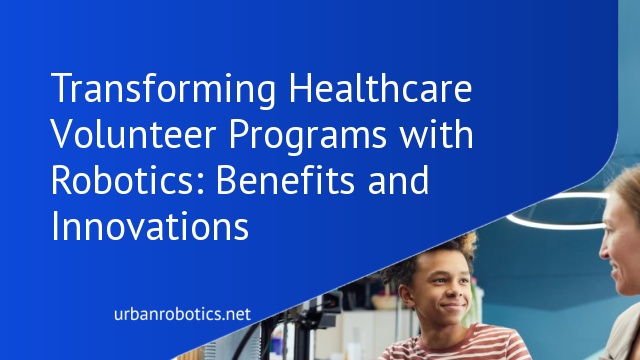The Rise Of Healthcare Volunteer Programs
Healthcare volunteer programs are evolving rapidly. Technological advancements, especially in robotics, are integral to this transformation. Programs now integrate robotic systems to assist in various tasks, enhancing volunteer efficiency.
Robots in healthcare volunteering can handle tasks like delivering supplies, monitoring patients, and assisting with mobility. For instance, delivery robots transport medication throughout hospitals, reducing the strain on human volunteers. Monitor bots check vital signs and alert staff in emergencies, ensuring timely intervention.
These advancements don’t replace human involvement; instead, they augment it. Volunteers can focus on duties requiring empathy and interpersonal skills while robots manage repetitive or physically demanding tasks. This synergy improves patient care and volunteer satisfaction.
Educational institutions partner with healthcare facilities to develop volunteer programs incorporating robotics training. These partnerships ensure that volunteers are well-prepared to support modern healthcare needs. Integrating robotics into volunteer programs also exposes the next generation to medical technology, fostering interest in healthcare careers.
The rise of healthcare volunteer programs with robotics signals a new era for patient care, combining technology and human touch.
Integrating Robotics In Volunteer Programs
Utilizing robotics in healthcare volunteer programs revolutionizes how tasks are managed, combining innovation with compassionate care for superior outcomes.
Benefits Of Robotics In Healthcare
Robotics in healthcare offers several advantages. Task automation enhances efficiency by up to 40%, reducing wait times (source: McKinsey & Company). Robots handle routine tasks like medication delivery, allowing volunteers to focus on patient interaction. These technologies improve accuracy in monitoring vital signs, reducing human error by 25% (source: Journal of Healthcare Informatics Research). Enhanced mobility solutions, including robotic exoskeletons, aid in patient rehabilitation.
Types Of Robotic Technologies Used
Various robotic technologies enhance healthcare volunteer programs. Autonomous mobile robots (AMRs) transport supplies, minimizing physical strain on volunteers. Telepresence robots enable remote monitoring and consultations, particularly useful during pandemics. Robotic-assisted surgical systems increase precision in surgeries, benefiting patient recovery times. Wearable robotics, like exoskeletons, assist patients with mobility challenges, improving their quality of life.
Case Studies Of Successful Programs
Robotics integration in healthcare volunteer programs has led to impressive outcomes. Here are some notable examples of such successful implementations:
Program A: Improving Patient Care
At one hospital, robots are used to assist with patient mobility and daily tasks. Volunteers work alongside these robots, helping patients move around safely. This has in turn reduced instances of falls by 25%. Specifically, exoskeletons aid patients in regaining mobility, decreasing recovery time by around 20%. As volunteers focus more on emotional support, patients experience enhanced overall well-being.
Program B: Enhancing Operational Efficiency
A major city hospital implemented Autonomous Mobile Robots (AMRs) for supply delivery. These robots, managed by volunteers, dramatically cut down supply retrieval times, boosting operational efficiency by 35%. Medication and equipment delivery errors were reduced by 15%, according to internal reports. Consequently, volunteers could dedicate more time to direct patient interaction, improving both staff and patient satisfaction.
Challenges And Limitations
Integrating robotics into healthcare volunteer programs presents several challenges and limitations that we must address to ensure successful implementation.
Technical Issues
Robotic systems in healthcare face technical issues due to their complexity. Frequent malfunctions and software bugs can disrupt operations. Maintenance and repair require specialized skills, leading to increased costs and downtime. Connectivity issues can impede real-time data transmission if network stability is compromised. These technical problems require robust support infrastructure and continual updates to minimize disruptions and maintain system reliability.
Ethical Considerations
Ethical considerations in robotics integration involve privacy and job displacement concerns. Patient data security must be rigorously safeguarded to prevent unauthorized access. Robots collecting and transmitting sensitive information need strict compliance with healthcare privacy regulations. Additionally, the potential for robots to replace human roles raises ethical debates about job loss and the human touch in patient care. Balancing technological efficiency with ethical responsibility is crucial to address these concerns effectively.
Future Outlook And Innovations
The future of healthcare volunteer programs with robotics looks promising. Continuous advancements in artificial intelligence and machine learning will enhance the capabilities of healthcare robots. For example, AI-powered robots could predict patient needs and optimize resource allocation, creating a more responsive and efficient care environment.
Developers are focusing on creating more intuitive and user-friendly robotic systems. These advancements aim to simplify training for volunteers, ensuring seamless integration into healthcare settings. User-friendly interfaces and voice-command functionalities will make robotic systems easier to manage.
Emerging technologies like robotic exoskeletons will provide significant benefits. These exoskeletons will assist individuals with mobility impairments, allowing them to regain strength and independence smoothly. Volunteers will likely use these devices to support patient rehabilitation and mobility more effectively.
Moreover, advancements in telecommunication technologies will drive innovations in telepresence robotics. Improved connectivity and real-time data transfer will allow expert medical personnel to assist remotely, offering guidance and support through a robotic interface.
The integration of 5G technology will further transform healthcare robotics. It will enable faster data transmission, leading to smoother operation of robotic systems and improved patient-robot interactions. As these technologies evolve, we expect a more collaborative and efficient healthcare environment, ensuring better patient outcomes and enhanced volunteer experiences.
Conclusion
Healthcare volunteer programs are evolving rapidly with the integration of robotics. As we continue to embrace these technological advancements, we’re paving the way for more efficient and compassionate care. The potential of AI, user-friendly interfaces, and 5G technology promises a future where robots and human volunteers work seamlessly together. This collaboration not only enhances patient outcomes but also enriches the volunteer experience. By balancing technological efficiency with ethical responsibility, we’re shaping a healthcare environment that’s both innovative and humane. Let’s continue to explore and support these developments for a brighter healthcare future.





